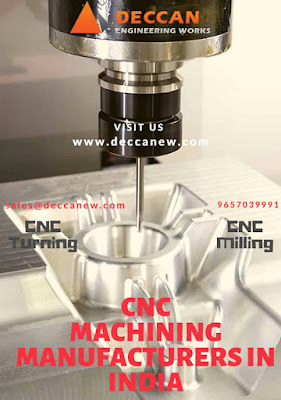The 5 Most Common Types of Precision CNC Machining
CNC machining is an overall term utilized for a wide assortment of machining applications. "CNC" is a numerically controlled and programmable feature of a computer, which allows the machine to perform many tasks with minimal human control. CNC machining is the production of components using CNC-controlled machines. The term subtraction describes a range of production processes where the material is extracted from the workpiece or bar to form part of the material component. There are 5 common types of CNC machining that are done by 5 different types of CNC machines.
These processes are used in many industries including medical, aerospace, industrial, oil and gas, hydropower, fireworks, etc.
CNC machining CNC offers many advantages over machining without programmable capabilities. Significantly reduced cycle times have been improved and multiple features can be met at the same time and quality and consistency can be improved. It is suitable for medium and high volume requirements where accuracy and complexity are required.
Precision CNC machining gives a wide creation ability to machining parts and completing underway conditions. Depending on the environment of use, required materials, lead time, volume, budget, and required features, there is usually an optimal method to give the desired result.
Types of Precision CNC Machining
CNC Lathes and Turning Machines
CNC lathes and turning machines are characterized by the ability to rotate materials during machining operation. Cutting tools for this machine are supplied in linear motion with rotating bar stock; Draw the material around the perimeter until the desired diameter (and feature) is achieved.
A subset of CNC machines is CNC Swiss machines. With the CNC Swiss lathe, the material bar rotates and slides axially through the guide bushing that enters the machine. This tooling provides good support for the material due to the features of the machine parts.
The CNC machine and turning machine can deliver interior and outside highlights on the segment: punctured bore, bore, clasps, changed opening, space, tapping, tighten and string. Segments made on CNC machines and turning focuses incorporate screws, fasteners, shafts, poppets, and so on
CNC Milling Machines
CNC milling machines are characterized by their ability to rotate cutting tools while keeping workpieces / blocks stable. They can create a wide range of shapes, including face-milled features (shallow, flat surface and cavities in the workpiece) and peripheral milled features (deep cavities like slots and threads).
The components produced on a CNC milling machine are usually square or rectangular in shape with different characteristics.
CNC Laser Machines
A CNC laser machine is a pointed router with a highly targeted laser beam used for precise cutting, cutting or digging. The laser heats the material and it melts or evaporates, creating a cut in the material. Typically, the material is in the form of a sheet and the laser beam slides back and forth over the material to create an accurate cut.
This process can produce a wide range of designs compared to traditional cutting machines (lathes, turning centers, mills) and often produces cuts and / or edges that do not require an additional finishing process.
CNC laser engravers are used for part marking (and decoration) of machining components. For example, the logo and company names in a CNC turn or CNC milled component can be difficult for the machine. However, laser engraving can be used to add these components even after machining operations have been completed.
CNC Electrical Discharge Machines (EDM)
The CNC Electric Discharge Machine (EDM) uses a highly controlled electric spark to handle the material to the desired size. It can also be called spark eroding, dye sinking, spark machining or wire burning.
A component electrode is placed under the wire and the machine is programmed to release an electrical discharge from the wire that generates intense heat (up to 21,000 degrees Fahrenheit). The material is melted or flushed with liquid to form the desired shape or characteristic.
EDM is often used to create precise micro-hole, slot, tapered or angle features and various other complex features in components or workpieces. It is usually used for extremely hard metals which will make the machine hard for the desired shape or feature. A great example of this is typical gear.
CNC Plasma Cutting Machines
CNC plasma cutting machines are also used for cutting material. However, they perform this operation using a computer-controlled high-power plasma (electron-ionized gas) torch. Plasma torches achieve up to 50,000 degrees Fahrenheit, such as hand-held gas-fired torches (up to 10,000 degrees Fahrenheit) used for welding. The plasma torch melts through the workpiece to create a cut in the material.
As a requirement, whenever CNC plasma cutting is used, the material to be cut must be electrically conductive. Typical materials are steel, stainless steel, aluminum, brass and copper.
Precision CNC machining provides a wide production capacity for machining components and finishing in production environments. Depending on the environment of use, required materials, lead time, volume, budget and required features, there is usually an optimal method to give the desired result.
Deccan Engineering Works in the year 1980 specializes in the manufacturing of precision CNC machining and high-quality work services. We continue to grow exponentially in this sphere; courtesy of our high level of comprehending client and customer requirements and new demands in an ever-changing manufacturing world. More information about then Visit http://www.deccanew.com/precision-cnc-machining.php



Comments
Post a Comment